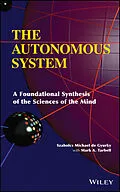The Fundamental Science in "Computer Science" Is the Science
of Thought
For the first time, the collective genius of the great
18th-century German cognitive philosopher-scientists Immanuel Kant,
Georg Wilhelm Friedrich Hegel, and Arthur Schopenhauer have been
integrated into modern 21st-century computer science.
In contrast to the languishing mainstream of Artificial
Intelligence, this book takes the human thought system as its
model, resulting in an entirely different approach. This book
presents the architecture of a thoroughly and broadly educated
human mind as translated into modern software engineering design
terms.
The result is The Autonomous System, based on dynamic
logic and the architecture of the human mind. With its human-like
intelligence, it is capable of rational thought, reasoning, and an
understanding of itself and its tasks.
"A system of thoughts must always have an architectural
structure."
--Arthur Schopenhauer, The World as Will and
Presentation
Autorentext
SZABOLCS MICHAEL de GYURKY was the Voyager Project
Science Data Chief and a Technical Principal/Technical Manager at
the Jet Propulsion Laboratory, retiring after twenty-five years. He
was awarded the NASA Exceptional Achievement Medal for
technological advancements of fundamental importance. He has long
been fascinated by the concept of computer science as an
abstraction of the human thought system and the role of the
cognitive sciences in computer science. He is the author of The
Cognitive Dynamics of Computer Science (Wiley).
MARK A. TARBELL is a Visiting Scientist at the California
Institute of Technology's Visual and Autonomous Exploration Systems
Research Laboratory. For the last twenty-five years, he has
immersed himself in large-scale computer science, aerospace, and
biomedical project development for NASA, Caltech, and JPL. He is
the recipient of the NASA Certificate of Recognition for Creative
Development of Technical Innovation, co-recipient of the R&D
100 Award in biomedicine, and holds patents in the fields of
aerospace and biomedical technologies.
Zusammenfassung
The Fundamental Science in "Computer Science" Is the Science of Thought
For the first time, the collective genius of the great 18th-century German cognitive philosopher-scientists Immanuel Kant, Georg Wilhelm Friedrich Hegel, and Arthur Schopenhauer have been integrated into modern 21st-century computer science.
In contrast to the languishing mainstream of Artificial Intelligence, this book takes the human thought system as its model, resulting in an entirely different approach. This book presents the architecture of a thoroughly and broadly educated human mind as translated into modern software engineering design terms.
The result is The Autonomous System, based on dynamic logic and the architecture of the human mind. With its human-like intelligence, it is capable of rational thought, reasoning, and an understanding of itself and its tasks.
"A system of thoughts must always have an architectural structure."
Arthur Schopenhauer, The World as Will and Presentation
Inhalt
Preface xiii
Introduction xix
1. The Architecture of the Autonomous System 1
1.1 Introduction, 1
1.2 The System Constellation, 1
1.3 System Constellation Architectural Overview, 3
1.4 The Constellation Architecture, 5
1.5 The Software Systems Comprising the Constellation, 8
2. The Architectural Methodology 22
2.1 Articulation of the Requirements and Design, 23
2.2 System Development and Integration Testing, 30
2.3 Phase I: The Idea, 33
2.4 Making Rational Judgments, 36
2.5 Phase II: The Concept, 38
2.6 Using JPL-STD-D-4000 for System Requirements, 39
3. The Architecture of the Will System 41
3.1 The Search for Truth, 41
3.2 The Nature of the Will, 45
3.3 Das Ding an Sich, 45
3.4 The Will as a System, 49
3.5 The Architecture of the Will System, 51
3.6 The Interfaces of the Will System, 53
3.7 The Subsystems of the Will System, 54
4. The Architecture of the Reason System 62
4.1 The Reason and Ethics, 62
4.2 The Nature of the Reason, 64
4.3 The Reason as a System, 65
4.4 The Architecture of the Reason System, 65
4.5 The External Interfaces of the Reason, 67
4.6 The Subsystems of the Reason, 68
5. The Architecture of the Intellect System 74
5.1 The Intellect as a System, 74
5.2 The Nature of the Intellect, 77
5.3 The Intellect as a System, 79
5.4 The Subsystems of the Intellect System, 80
5.5 The External Interfaces of the Intellect System, 81
6. The Architecture of the Presentation System 83
6.1 The Presentation System, 84
6.2 The Presentation as a System, 86
6.3 The Subsystems of the Presentation, 86
7. The Architecture of the Understanding System 90
7.1 The Understanding as a System, 92
7.2 The External Interfaces of the Understanding, 94
8. The Architecture of the Sensory System 98
8.1 The Sensory System, 98
8.2 The Architecture of the Sensory System, 100
8.3 The Phenomenon Subsystem, 101
8.4 A Historical Perspective on Languages, 104
8.5 The Workings of the Noumenon, 105
9. The Architecture of the Decision System 107
9.1 The Process of Decision Making, 107
9.2 Understanding the Decision Process, 111
9.3 The Decision as a System, 113
9.4 The Subsystems of the Decision System, 114
9.5 The Interfaces of the Decision System, 121
9.6 The Building of Preferences, 121
10. The Architecture of the Thought System 124
10.1 The "Movers" of the Thought Process, 125
10.2 The Pursuit of Thinking, 127
10.3 The Nexus Cogitationis, 128
10.4 The Subsystems of the Thought System, 130
10.5 Initialization Process of the Autonomous System, 136
Epilogue 142
Endnotes 144
Index 155
